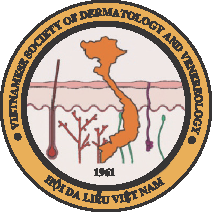THE DIAGNOSIS OF ALOPECIA AREATA BY DERMOSCOPY
DOI:
https://doi.org/10.56320/tcdlhvn.v35i.4Keywords:
alopecia areata, dermoscopyAbstract
Objectives: The aim was to determine the relationship between the clinical and the dermoscopic findings of alopecia areata.
Subjects and methods: It was a cross-sectional and observational study of each dermoscopy feature in Alopecia Areata. The study was conducted from August 2020 to August 2021 in 86 patients in the National hospital of Dermatology and venereology.
Results: In had 86 cases, 95,3% had Patchy Alopecia Areata, 3,5% had Alopecia Ophiasis, one patient Alopecia Universalis, no one had Alopecia Totalis. Regarding the extent of hair loss, 91,9% had S1. Hair pull test was positive in 9/86 patients. The characteristic follicular features of Alopecia Areata on Dermoscopy included yellow dots, black dots, broken hair, short vellus hair accounted for more than 50%. Meanwhile tapering and uprright re-growing hair and circle hair accounted for 39,5%, 8,1%, respectively analysis of the relationship between the clinical and the dermoscopic findings of Alopecia Areata showed that yellow dots, black dots, uprright re-growing were most commonly present in Patchy Alopecia Areata (58,5%; 62,1%; 40,2%). Other characteristics such as broken hair, tapering hair, short vellus hair and circle hair were most common in Alopecia Ophiasis. However, except for Patchy Alopecia Areata, sample sizes of other subtypes were too small, so the research results were not representative of the population.
The correlation between the severity (SALT) and the dermoscopic findings of Alopecia Areata, was not statistically significant (p>0,05) in this study.
The disease activity was defined by hair pull test. The relationship between the incidence of black dot and the disease activity was statistically significant with p=0,009.
Conclusion: Dermoscopy is a safe and useful technique in the diagnosis of Alopecia Areata. The correlation between the clinical, the severity (SALT) and the dermoscopic findings of Alopecia Areata, was not statistically significant (p>0,05) in this study. The appearance of black dots is a sign that the disease is in an active stage.





